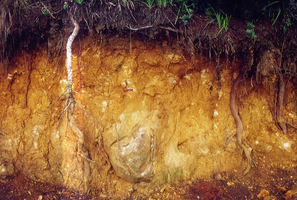WP 1: Making Soil from Rock
The chemical interaction between rocks and atmospheric fluids (e.g. water, carbon dioxide, oxygen) produces residual minerals such as clays or carbonates that constitute soil and river sediment. A better understanding of these processes is needed to build predictive tools for soil production and destruction rates. Similarly, the rates and processes behind biotic weathering reactions affecting building stones are poorly known. In this WP, we will study the biotic and abiotic mechanisms that govern these interactions from the scale of the mineral surface (µm-scale) to that of a soil (m-scale). In particular, we intend to characterize the novel stable isotope signatures corresponding to the different mineral dissolution and precipitation reactions that occur when soil is made from rocks. Mineral-scale analyses in WP1 will be carried out based on the analytical progress made in WP5. The main output of this WP will be (1) the isotope fingerprints of natural processes such as mineral dissolution, clay formation, and uptake by plants for an array of novel isotope systems, and (2) a predictive model for soil development and destruction. The knowledge acquired on the elementary processes in WP1 will be upscaled to the hillslope and river basins spatial scales in WP2.
WP Leaders
Eric Oelkers, Géosciences environnement Toulouse
Anna Gorbushina, Federal Institute for Materials Research and Testing
Further WP partners
Boliden Tara Mines Limited
Institut de physique du globe de Paris
Teck Ireland Ltd.
GFZ German Research Centre for Geosciences



